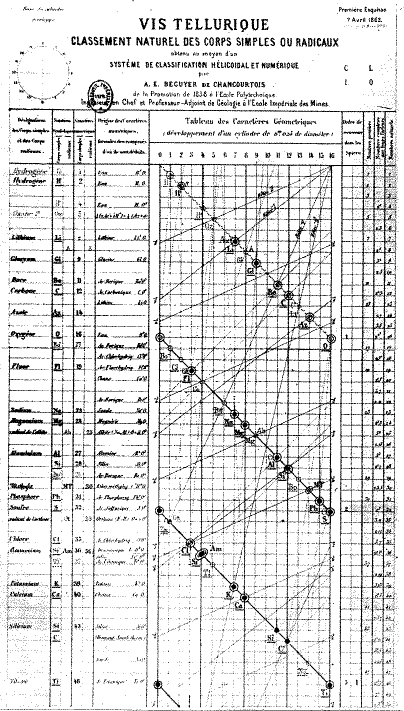
Alexandre-Emile Béguyer de Chancourtois (1820-1886)
On January 20, 1820, French geologist and mineralogist Alexandre-Émile Béguyer de Chancourtois was born. De Chancourtois was the first to arrange the chemical elements in order of atomic weights in 1862. De Chancourtois only published his paper, but did not publish his actual graph with the irregular arrangement. Although his publication was significant, it was ignored by chemists as it was written in terms of geology. It was Dmitri Mendeleev’s table published in 1869 that became most recognized.[3]
Alexandre-Émile Béguyer de Chancourtois – Early Life
Born in Paris, France, the son of an architect, Alexandre-Émile Béguyer de Chancourtois entered France’s famous École Polytechnique at the age of 18 and was a student of Jean-Baptiste Élie de Beaumont, whose assistant he should become, as well as Pierre Guillaume Frédéric le Play, and metallurgist Ours-Pierre-Armand Petit-Dufrénoy. After completing the studies, de Chancourtois went on a biological expedition into Philippines, Luzon and Visayas, where he explored ore deposits and geology on behalf of his teachers. He joined the École Nationale Supérieure des Mines de Paris as professor of mine surveying. De Chancourtois was named the professor of geology at École Nationale Supérieure des Mines de Paris in 1852 and was awarded the Légion d’honneur by Napoleon III of France during the late 1860s. De Chancourtois led several overseas expeditions during the course of his life and served as the Inspector of Mines in Paris from 1875 until his death.
Further Activities
He supervised the collections of the École des Mines, was involved in geological maps from overseas and was subdirector of the service of the geological map of France and was also associated with Frédéric Le Play, whom he assisted in organizing the first World Exhibition in 1855 and for whom he produced industrial statistics. He proposed the creation of seismographic stations and improved safety in mines (ventilation and protection against explosions). In order to find a field of activity independent of his teachers, he turned to geography and made a long effort to introduce a geographical system (with a zero meridian in the Atlantic Ocean (meridian of Saint-Michel) and a metric system) independent of British dominance at the international level. But since the zero meridian required an observatory, Greenwich finally prevailed. Another equally unsuccessful project was the introduction of an international sound rewriting system in geography.

De Chancourtois’s original organization of the elements
Organizing the Chemical Elements
During the early 1860s and before John Alexander Reina Newlands, de Chancourtois created a new and unique system to organize the chemical elements. De Chancourtois’s proposed system was based on the newest values of atomic weights obtained by Stanislao Cannizzaro in 1858. He managed to devise a spiral graph that was arranged on a cylinder which he called vis tellurique, or telluric helix because tellurium was the element in the middle of the graph. De Chancourtois ordered the elements by increasing atomic weight and with similar elements lined up vertically.
De Chancourtois graphed the atomic weights of elements on a cylinder with a circumference of 16 units, which was approximately equal to the atomic weight of oxygen. The resulting helical pattern, named the “square circle triangle” by de Chancourtois, aligned similar elements on corresponding points above or below each other on the cylinder. Through this method, de Chancourtois was the first to observe the periodic nature of elements when arranged by atomic weight, noting that similar elements occurred at regular intervals. The English chemist John A. R. Newlands later described this pattern as an “octave rule” due to its octave periodicity of similar elements.
Later Life
However, de Chancourtois’ work, his publication attracted little attention from chemists around the world. He presented the paper to the French Academy of Sciences which published it in Comptes Rendus, the academy’s journal and the original diagram was left out of the publication, making the paper hard to comprehend. Only in 1869, Dmitri Mendeleyev‘s periodic table attracted attention and gained widespread scientific acceptance [3]. Chancourtois became commander of the Legion of Honour (1867, already in 1856 he was its officer), became titular professor and Ingénieur général des mines. However, the post of subdirector of the service of the geological map of France was withdrawn from him in 1875. Throughout his lifetime, De Chancourtois embarked on several overseas expeditions and served as the Inspector of Mines in Paris from 1875 until his passing. In his role as a mine inspector, he implemented safety regulations to prevent the frequent methane gas explosions that were occurring at the time.
Alexandre-Émile Béguyer de Chancourtois died in 1886 in Paris at age 66..
Catherine Drennan, 8. The Periodic Table and Periodic Trends, [8]
References and Further Reading:
- [1] Organizing the Elements
- [2] The History of the Periodic Table of the Elements at Britannica
- [3] Dmitri Mendeleev and the Periodic Table of Elements, SciHi Blog, February 2, 2015.
- [4] Works by or about Alexandre-Émile Béguyer de Chancourtois at Internet Archive
- [5] M. Beguyer de Chancourtois (1862). “Mémoire sur un classement naturel des corps simples ou radicaux appelé vis tellurique 54, 757–761″
- [6] Jacques Touret: Dans l’ombre de ses maîtres : Alexandre-Eugène Béguyer de Chancourtois (1820-1886)
- [7] Alexandre-Émile Béguyer de Chancourtois at Wikidata
- [8] Catherine Drennan, 8. The Periodic Table and Periodic Trends, MIT 5.111 Principles of Chemical Science, Fall 2014, MIT OpenCourseWare @ youtube
- [9] Alexandre-Émile Béguyer de Chancourtois, “Sur la distribution des minéraux de fer,” in Comptes rendus de l’Académie des sciences, 51 (1860), 414–417.
- [10] Alexandre-Émile Béguyer de Chancourtois, “Vis tellurique,” in Comptes rendus de l’Académie des sciences, 54 (1862), 757–761, 840–843, 967–971.
- [11] Timeline for Béguyer de Chancourtois, via Wikidata





